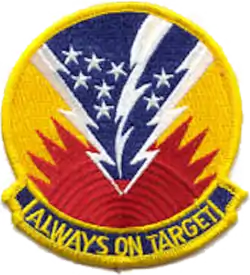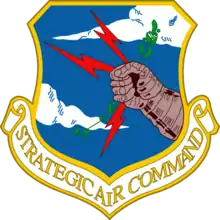62nd Bombardment Squadron
The 62d Bombardment Squadron is an inactive United States Air Force unit. It was last assigned to the 2d Operations Group at Barksdale Air Force Base, Louisiana on 18 January 1993.
| 62d Bombardment Squadron | |
|---|---|
 Emblem of the 62d Bombardment Squadron | |
| Active | 1941-1944; 1944-1945; 1962-1 Sep 1991 |
| Country | United States |
| Branch | United States Air Force |
| Type | Bombardment |
History
Established in 1941 as a B-17 Flying Fortress heavy bomber squadron, it was assigned to the GHQAF Northwest Air District in Washington State in July 1941. It flew antisubmarine patrols over the Pacific Northwest coastline after the Pearl Harbor attack. Its aircraft and crews were sent to Australia in early 1942, they were assigned to Fifth Air Force units being formed there after the withdrawal of B-17s from Clark Field in January 1942 after operations from Clark became untenable during the 1942 Battle of the Philippines.
The squadron reformed at Davis-Monthan Field, Arizona in February 1942 as a B-24 Liberator heavy bomber Operational Training Unit under the Second Air Force. It trained new units and replacement crews until heavy bomber training ended in April 1944.
B-29 Superfortress operations against Japan
Re-designated on 1 April 1944 as a B-29 Superfortress Very Heavy bombardment squadron. When training was completed moved to North Field Guam in the Mariana Islands of the Central Pacific Area in January 1945 and assigned to XXI Bomber Command, Twentieth Air Force. Its mission was the strategic bombardment of the Japanese Home Islands and the destruction of its war-making capability.
Flew "shakedown" missions against Japanese targets on Moen Island, Truk, and other points in the Carolines and Marianas. The squadron began combat missions over Japan on 25 February 1945 with a firebombing mission over Northeast Tokyo. The squadron continued to participate in wide area firebombing attack, but the first ten-day blitz resulting in the Army Air Forces running out of incendiary bombs. Until then the squadron flew conventional strategic bombing missions using high explosive bombs.
The squadron continued attacking urban areas with incendiary raids until the end of the war in August 1945, attacking major Japanese cities, causing massive destruction of urbanized areas. Also conducted raids against strategic objectives, bombing aircraft factories, chemical plants, oil refineries, and other targets in Japan. The squadron flew its last combat missions on 14 August when hostilities ended. Afterwards, its B 29s carried relief supplies to Allied prisoner of war camps in Japan and Manchuria.
Squadron remained in Western Pacific, although largely demobilized in the fall of 1945. Some aircraft scrapped on Tinian; others flown to storage depots in the United States. Inactivated as part of Army Service forces at the end of 1945.
Strategic Air Command
It was reactivated as a Strategic Air Command B-52G Stratofortress intercontinental strategic bombardment squadron in 1963, receiving the mission, personnel, aircraft, and equipment of the 301st Bombardment Squadron, which was inactivated. This was part of a Strategic Air Command (SAC) program to provide units with a combat lineage. The squadron performed operational testing of new equipment at Eglin AFB, between 1963 and 1965; it was reassigned to Barksdale AFB in 1965 and stood nuclear alert duties. It deployed to the western Pacific and engaged in combat operations over Indochina as part of Operation Arc Light (1966–1972). The unit returned to training status and stood nuclear alert after the end of the Vietnam War. Aircraft and personnel of the squadron deployed to 806th Provisional Bombardment Wing at RAF Fairford, England, Jan-Mar 1991 (Operation Desert Storm). It was inactivated in 1993 as part of the USAF drawdown after the end of the Cold War and retirement of the B-52G.
Operations and decorations
- Combat Operations: Conducted bombardment missions against Japan, c. 6 Apr-14 Aug 1945.
- Campaigns: World War II: Western Pacific; Air Offensive, Japan.
- Decorations: Distinguished Unit Citations: Japan, 10 May 1945; Tokyo and Yokohama, Japan, 23–29 May 1945.
Lineage
- Constituted as the 62d Bombardment Squadron (Heavy) on 20 November 1940
- Activated on 15 January 1941
- Inactivated on 1 April 1944
- Redesignated the 62d Bombardment Squadron, Very Heavy and activated on 1 April 1944
- Inactivated on 27 December 1945
- Redesignated the 62d Bombardment Squadron, Heavy and activated, on 15 November 1962 (not organized)
- Organized on 1 February 1963
- Inactivated on 18 January 1993
Assignments
- 39th Bombardment Group, 15 January 1941 – 1 April 1944
- 39th Bombardment Group, 1 April 1944 – 27 December 1945
- Strategic Air Command, 15 November 1962 (not organized)
- 39th Bombardment Wing, 1 February 1963
- 2d Bombardment Wing, 25 June 1965
- 2d Operations Group, 1 September 1991 – 18 January 1993
Stations
|
|
Aircraft
- B-17 Flying Fortress, 1941–1942
- B-24 Liberator, 1942–1944
- B-29 Superfortress, 1944–1945
- B-52 Stratofortress, 1963–1993
References
![]() This article incorporates public domain material from the Air Force Historical Research Agency website http://www.afhra.af.mil/.
This article incorporates public domain material from the Air Force Historical Research Agency website http://www.afhra.af.mil/.

.png.webp)